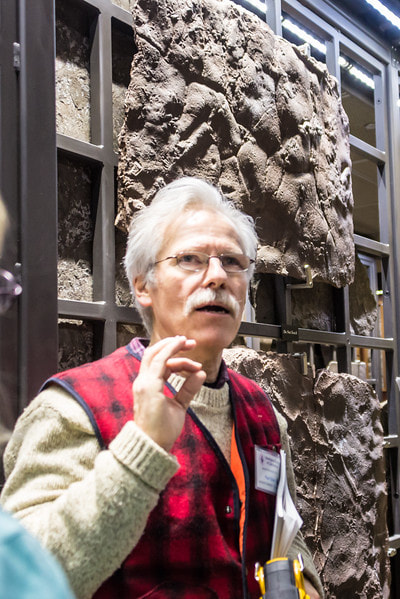2023 GSC Annual Meeting
|
WHEN:
Friday, November 3 at 5pm. WHERE: Trinity College, Hartford, Connecticut
parking lot or parking space. Parking is also available along Summit St. and by the field house. SCHEDULE: 5:00 – 6:00 Happy Hour 6:00 – 8:00 Dinner, Business Meeting, Raffle, CT Geology Quiz Drawing 8:00 - 9:00 Talk by Paul Olsen SPEAKER: Paul Olsen PRESENTATION: "Volcanic Winters from Supereruptions at the Dawn of the Age of Dinosaurs" Registration closed October 26, 2023. |
As many of you know, the annual meeting presents a wonderful opportunity to socialize with geologists of all stripes from across the State and to learn something new about the rocks beneath our feet. This year, our keynote speaker, Paul Olsen,
shared some of his latest thoughts on the demise of terrestrial organisms during the end-Triassic
mass extinction. All were welcome at this event!
shared some of his latest thoughts on the demise of terrestrial organisms during the end-Triassic
mass extinction. All were welcome at this event!
About the presentation:
Deadly volcanic winters of the Central Atlantic Magmatic Province (CAMP), not global warming from volcanic CO2, fit the pattern of extinctions, migrations, and adaptations on land during the end-Triassic mass extinction (ETE) 202 million years ago. This is despite clear evidence of CAMP-derived atmospheric CO2 doublings that resulted in global warming. However, land animal survivors
had burrowing habits or were from high latitudes and had insulation, consistent with cooling. This presents a conundrum: received wisdom has the basaltic CAMP incapable of producing major volcanic winters because its eruptions were not explosive. But this is wrong; rare CAMP airfall ashes from the Connecticut Valley and Newark rift basins were from supereruption plumes fully capable of
producing volcanic winters. Although such ashes are not visible at the level of the ETE because of pervasive preservational biases, I will show how geochemical and biotic ghosts of the killer volcanic winters are present at exactly the right level, providing a mechanism fitting the biotic pattern on land while still allowing CO2-driven acidification to cause the marine extinctions. Dinosaurs survived the ETE and took over the Jurassic landscape because they are fundamentally cold-adapted animals. On land, cold was the killer—not the heat.
Deadly volcanic winters of the Central Atlantic Magmatic Province (CAMP), not global warming from volcanic CO2, fit the pattern of extinctions, migrations, and adaptations on land during the end-Triassic mass extinction (ETE) 202 million years ago. This is despite clear evidence of CAMP-derived atmospheric CO2 doublings that resulted in global warming. However, land animal survivors
had burrowing habits or were from high latitudes and had insulation, consistent with cooling. This presents a conundrum: received wisdom has the basaltic CAMP incapable of producing major volcanic winters because its eruptions were not explosive. But this is wrong; rare CAMP airfall ashes from the Connecticut Valley and Newark rift basins were from supereruption plumes fully capable of
producing volcanic winters. Although such ashes are not visible at the level of the ETE because of pervasive preservational biases, I will show how geochemical and biotic ghosts of the killer volcanic winters are present at exactly the right level, providing a mechanism fitting the biotic pattern on land while still allowing CO2-driven acidification to cause the marine extinctions. Dinosaurs survived the ETE and took over the Jurassic landscape because they are fundamentally cold-adapted animals. On land, cold was the killer—not the heat.
Donate to the GSC Student Research Fund
Your donation supports the GSC Scholarship fund and other services.
The Geological Society of Connecticut is a non-profit IRS 501(c)(3) tax exempt organization.
Donations to the GSC may be U.S. tax deductible. Check with your tax advisor for details.
Use the "Donate" button below to make a direct donation
The Geological Society of Connecticut is a non-profit IRS 501(c)(3) tax exempt organization.
Donations to the GSC may be U.S. tax deductible. Check with your tax advisor for details.
Use the "Donate" button below to make a direct donation

